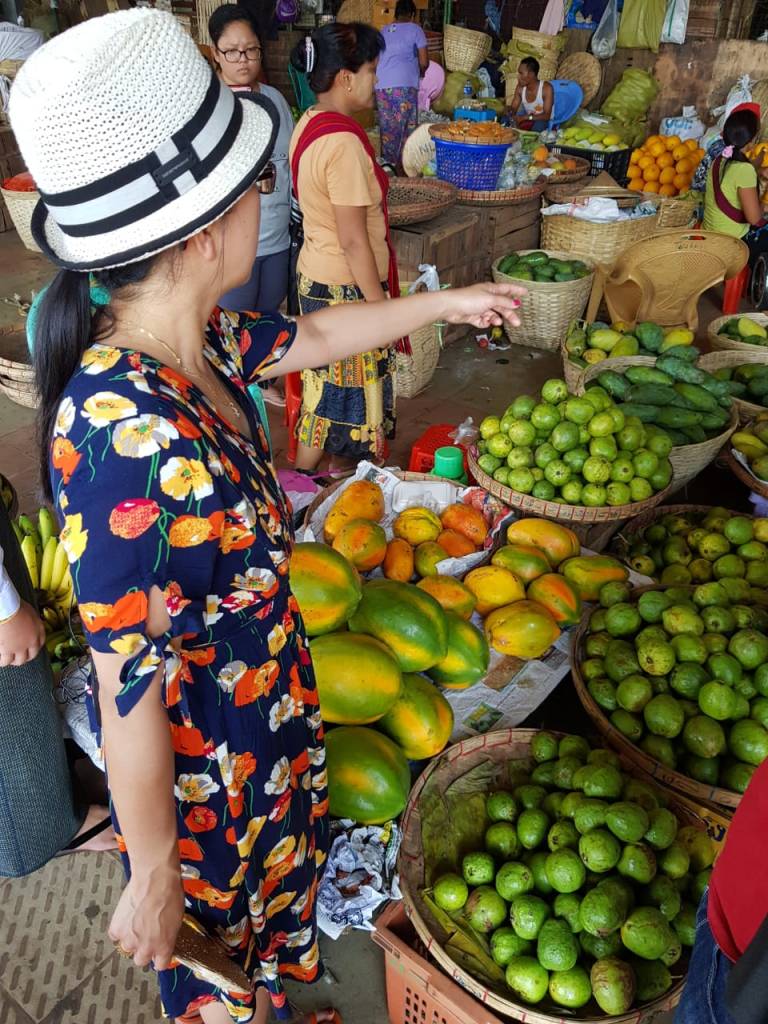Thiri Mingalar market is huge and open 24 hours. A bustling wholesale market used by everyone including locals and restaurants of all sizes including the Governor’s Residence. Chef Karl (Executive Chef at the luxury hotel that was once the British Governor’s residence built in 1920’s and beautifully restored, now part of the Belmond group), will guide us through the warren of alleyways filled with mountains of fresh fruit, vegetables, local delicacies essential to Burmese cooking, such as ‘ngapi‘, a fermented paste of shrimp or fish dried in the sun and used in small quantities in various dishes.
 Ngapi in various stages of production. I might add, a particularly pongy part of the market but the paste when added to cooking gives a delectable umami taste to the dish!
Ngapi in various stages of production. I might add, a particularly pongy part of the market but the paste when added to cooking gives a delectable umami taste to the dish!
The start is early so we breeze through the streets of Rangoon with relative ease to reach the market. The sun is already well and truly out and the humidity is pretty high and suffocating. Thankfully we spend seconds moving from car to building. Our guide and translator Ko Aung is full of interesting historical and cultural facts and figures. He also tells us the current temperature is about 36 degrees centigrade but will feel even hotter in the sun and the humidity level is about 55-65%. The possibility of rain is about 80% at around 8pm this evening. Quite precise! It seems like our guide is as much a keen amatuer weatherman as us Brits.
Today the producer/director (aka brother!) has assumed a further role as PR officer. I’m pleased as it makes my life easier, and with introductions and explanations about our project swiftly out of the way we are able to head off to the market.




So many fruits and vegetables have come into season such as the sweet honey mangoes, pineapples and watermelons. To be honest, the market is bursting with fresh produce, too many to name.

Chef Karl and his head chef visit the market every three days or so to see and buy whatever’s fresh. The hotel uses as much local produce as possible and visiting every few days allow the chefs to choose the freshest seasonal produce. However, despite this abundance they do have to supplement with imports from neighbouring Thailand because storage is better there and they can last a little bit longer than the produce grown in Burma. Unfortunately, due to the heat, humidity and lack of efficient transportation fresh produce grown in Burma can not be stored for long.

There is one interesting item, dha-nyin-thee. (I’ve been unable to determine the English name or its botanical name). I’d call it a fruit although it’s eaten as a savoury salad item.
Some prefer it dressed in oil and salt others like to dip in ‘ngapi-yay‘. (ngapi-yay is a condiment made with the shrimp paste ‘ngapi’. Water, garlic and chillies are added to taste. Interestingly, I would say it is very similar to the Italian Piedmontese dip called ‘bagna cauda’ which is made with salted anchovies and is eaten in a similar way.
A variety of raw and blanched vegetables are dipped into the salty garlicky sauce, such as dha-nyin-thee. It comes as a side dish to main courses.
This fruit is found only in the north of Burma and again, has just come into season. It is highly toxic and must be boiled for several hours. I didn’t realise this. The photo is sent immediately back to siblings on our whatsapp group. My eldest brother replied, Dad used to eat this smothered in oil and salt. Back in the day one of my Uncle’s from Burma often visited Tilbury docks as Captain of a merchant ship and would bring these rare delicacies to London.

The famous Sein ta-lone mangoes arrived fresh from the farmers this morning. Grown in hilly areas in North near the Mandalay region. It is considered the best and not found anywhere outside of Burma. It comes into season at the start of the rainy season and is named after its diamond shape. It is similar to the alphonso or honey mango variety. A must try if you are in Burma at this time of year.


It’s baking hot and a few hours is enough for all of us, so we head back to the Governor’s Residence to been shown how to cook some typical Burmese dishes….